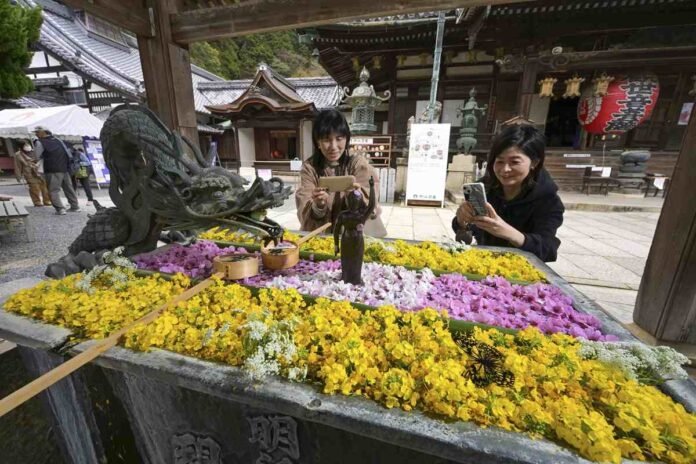Women take photos of colorful flowers in a ‘hanachozu’ at Yanagidani Kannon Yokokuji Temple in Nagaokakyo, Kyoto Prefecture.
11:26 JST, May 4, 2024
NAGAOKAKYO, Kyoto — At a temple or shrine in Japan, you’ve probably seen a pavilion that protects a fountain from which water drips. The water is called chozu, which means people must clean their hands and mouths before worshiping. The structure is called chozuya.
As I passed through a temple gate, a hanachozu caught my attention. A “hanachozu” is a chozu decorated with hana or flowers. Inside the chozuya, a thin stream of water flowed from a dragon-headed tap. Field mustard and cherry petals covered the surface of the water. Women took photos with their smartphones.
“Oh, how beautiful,” one of them exclaimed.
The Yanagidani Kannon Yokokuji Temple in Nagaokakyo, Kyoto Prefecture is believed to be the place where the practice of hanachozu began.
“We started doing it just for fun,” said Megumi Kusaka, 54, wife of Shunei Kusaka, 55, the temple’s high priest.
The temple is located in a mountainous area, about a 15-minute drive from the city center. Megumi was born and raised in the temple, which is believed to cure eye diseases. It has long attracted the faith of people with eye problems, but since then the number of visitors has declined and the temple buildings have become outdated. Megumi was afraid that the temple would become outdated.

Left: Camellia and cherry petals are placed together. Right: Yellow petals form a beautiful contrast with moss.
When Megumi looked around the garden in the summer of 2017, she suddenly felt like adding color to it. She wanted to plant kikyo, or balloon flowers, but that was not allowed because the temple had been designated as a place of scenic beauty by Kyoto Prefecture. When she sought permission from the prefectural government, an official told her that new plants had to be added carefully.
So instead, Megumi cut hydrangea flowers and let them float on the surface of the chozu water. The vibrant colors were striking and contrasted with the moss-covered chozu container. She thought the scene was so beautiful and decorated the basin with different grasses and flowers. Megumi posted the photos on social media and called the decoration hanachozu.
In the autumn of that year she applied red, yellow and green leaves in gradations over the entire surface of the water in the basin. The scene went viral after a photo of the hanachozu that a worshiper posted on social media received 100,000 likes. Since then, many visitors with cameras have visited the temple, and the number has increased rapidly.
“Putting flowers on water brings peace to my mind. Nothing else makes me happier than the smiles of visitors who see the flowers,” says Megumi.
Initially, some criticized her. One person said, “The water should be for purifying worshipers,” and another said, “The water cannot be used [for handwashing] similar.” But when the COVID-19 pandemic began, many other temples removed the ladles for chozu as a measure to prevent infections and instead decorated the chozu with flowers from each season.
Shunei says that the word hanachozu originally meant cleaning one’s hands outdoors with grass or flowers instead of water. However, the word has now become known to people in a different way: as a new way of spiritual healing.
“I hope that visitors can release their frustrations, even just a little, and become optimistic,” the high priest said.
Visitors to the temple can walk around the extensive grounds surrounded by mountains. Now Soshi, 23, the couple’s eldest son, has joined the work to create hanachozu, and there are nine hanachozu locations in the temple. It’s fun to look for the locations with the temple guidebook in hand.
When seeing the hanachozu, visitors forget the passage of time because they feel like they are looking at a work of art. In soft sunlight the flowers can be seen here and there.
Eye healing water

Jigen-ame candies, popular souvenirs from the temple
Water from a spring on the temple premises is believed to cure eye diseases. According to temple records, about 1,200 years ago, the Buddhist monk Kukai witnessed an adult monkey washing his child’s injured eye with spring water. When Kukai said a prayer, the child’s eye opened again. Kukai dug the soil of the site deeper and made the spring water spiritual water for people suffering from eye diseases.
Many people visit the temple and get the spring water. They can bottle the water to take home. The temple also sells amulets and talismans to pray for recovery from eye diseases. A popular souvenir is jigen-ame candy. A set contains eight pieces each and costs ¥400.
How to get there
The temple is about a 15-minute drive from Nagaoka-tenjin Station on the Hankyu Line or JR Nagaokakyo Station. In June, the temple hosts Ajisai Week, during which visitors can enjoy seeing about 5,000 blooming hydrangea flowers, and the Kamishoin Hall opens to the public as a special exhibition. Admission is typically ¥500, but is ¥700 during Ajisai week. Admission to Kamishoin Hall is subject to a surcharge.




